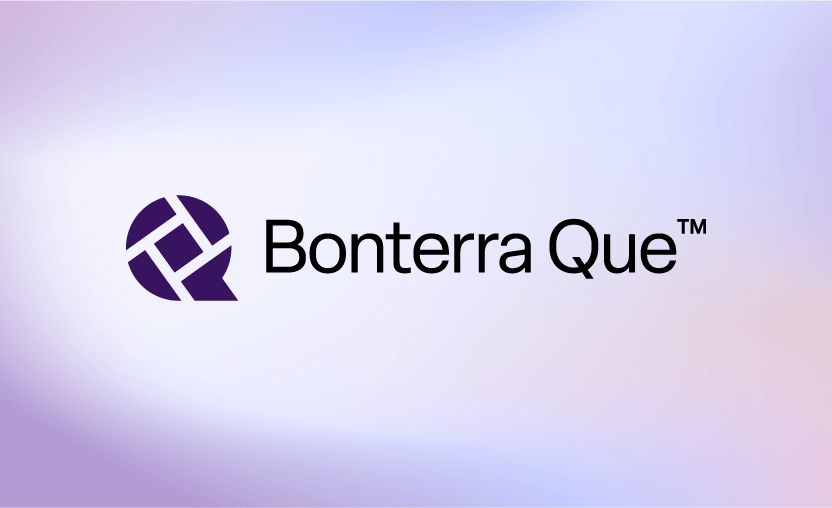Donor segmentation guide: How to leverage your donor data

Whenever your nonprofit organization acquires a new donor, you collect new data. Over time, as that donor continues to engage with your organization, you learn more about who they are, what they’re passionate about, and what kind of experiences they enjoy most. To maintain a strong relationship with this donor, you must put that data to use by personalizing your communications.
But how do you personalize the donor experience for each person if you have hundreds or thousands of supporters in your database? The answer is donor segmentation with the right donor management software.
Segmenting donors allows you to tailor outreach at scale, leading to more meaningful interactions, improved relationships, and increased donor retention rates. In this guide, we’ll explore donor segmentation and several strategies to boost engagement.
What is donor segmentation?
Donor segmentation is the process of dividing your organization’s supporters into groups based on shared characteristics. It’s essential for effective donor management and writing request letters, regardless of the size of your nonprofit’s donor base.
The donor segmentation process typically involves a few steps:
- Compile donor information in your donor database. Store all relevant data in your donor profiles, including demographic information, interests, and communication preferences.
- Analyze engagement data. Use your CRM’s data analysis features to note trends in individual giving and engagement behavior, such as which events they attend most often.
- Create donor segments. Group donors based on donors’ shared characteristics. For example, you might create one segment of older recurring donors and another for younger supporters who enjoy volunteering.
- Use segments to tailor communications. Personalize appeals and outreach for each group, speaking directly to their shared interests or needs to boost engagement.
There’s no limit to the number or scope of donor segments you create. You might create a large segment for mid-level donors, for instance, then break the group down into many smaller segments based on giving frequency, potential for upgrade, and more.
Why is donor segmentation important for fundraising?
According to the latest Fundraising Effectiveness Project Report, today’s nonprofits only retain 18.5% of first-time donors and 58.2% of repeat donors annually. Common reasons donors lapse include not feeling understood or valued by your nonprofit, so implementing donor segmentation can help you boost these retention rates and improve long-term fundraising results.
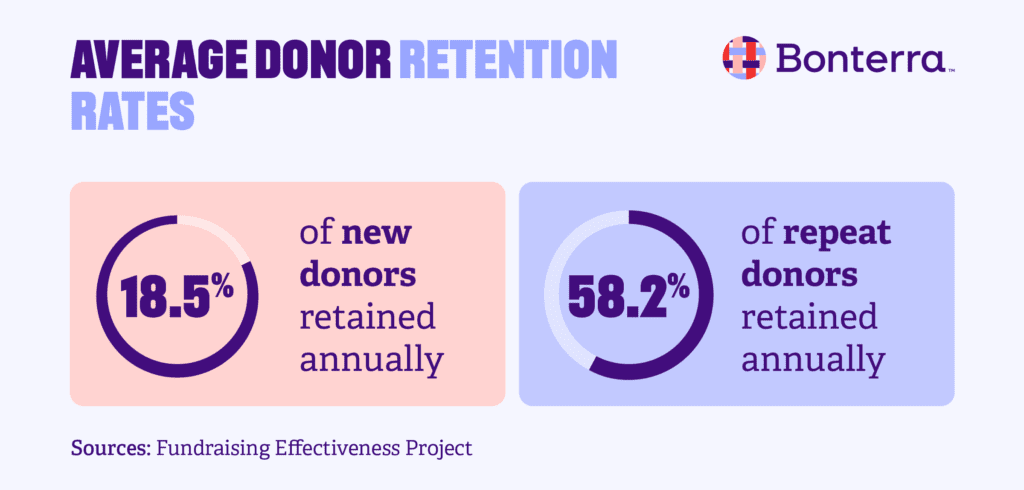
Strategic donor segmentation shows donors you’re paying attention to their interests, helps with stewardship efforts, and inspires more engagement and loyalty.
For example, say you send personalized online auction invitations to a group of donors who love events but live out of town. These donors will likely jump at the chance to engage with your nonprofit in a way they enjoy, and they’ll appreciate that you took the time to consider their needs. Ultimately, these donors will be more likely to continue supporting your organization long-term.
What data do you need for donor segmentation?
Effective segmentation relies on having healthy, complete donor data. Before you can create the best segments for your nonprofit, you’ll need to compile many types of personal information in your donor management platform. This typically includes:
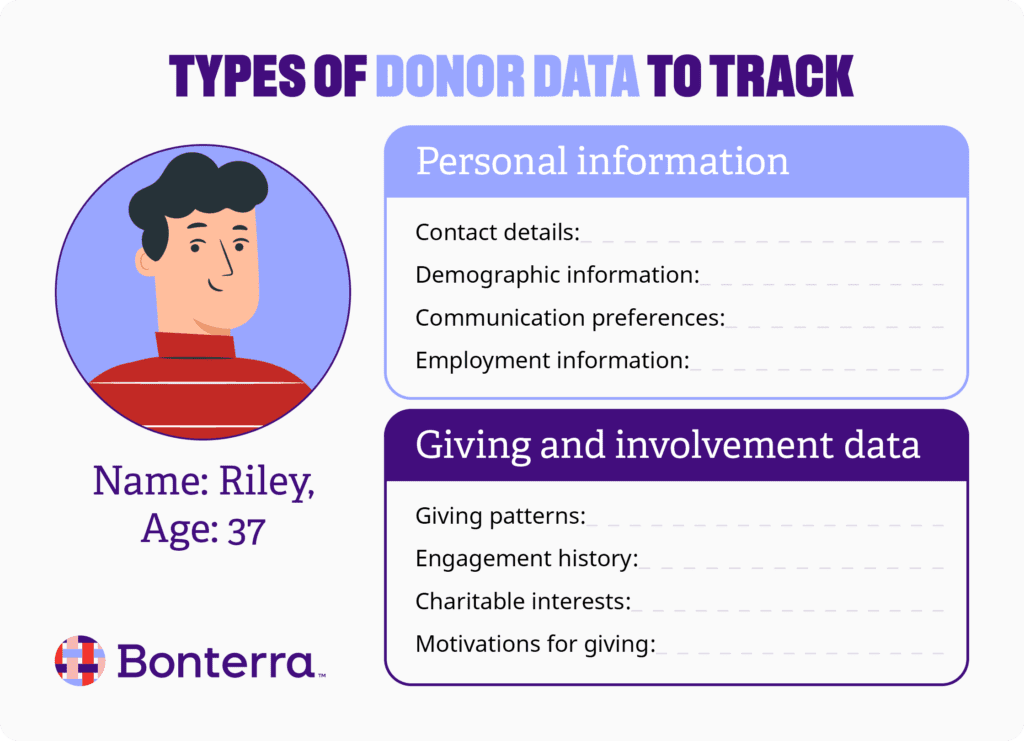
- Contact details that are accurate and up-to-date.
- Demographic information like gender, age, location, and level of education.
- Communication preferences, such as whether they prefer email or text messages.
- Employment information like their job title and the industry they work in.
- Giving patterns, including donation frequency, giving level, and which type of campaigns they donate to most often.
- Engagement history that includes events attended, advocacy actions taken, social media posts shared, and other ways they’ve interacted with your organization.
- Charitable interests, such as a specific aspect of your cause they’re passionate about.
- Motivations for giving which you learned from surveys, conversations, or other research.
A quality donor database will help you store all of this information in individual donor profiles and glean any insights you may have missed.
For example, Bonterra EveryAction enables you to track Engagement Points that quantify each donor’s engagement level. Our software also comes equipped with moves management and donor prospecting tools that help you segment donors based on their giving potential.
Common ways to segment nonprofit donors
Now that you know the basics, let’s explore some of the most common ways nonprofits use donor segmentation. Organizations often segment their donors using factors like:
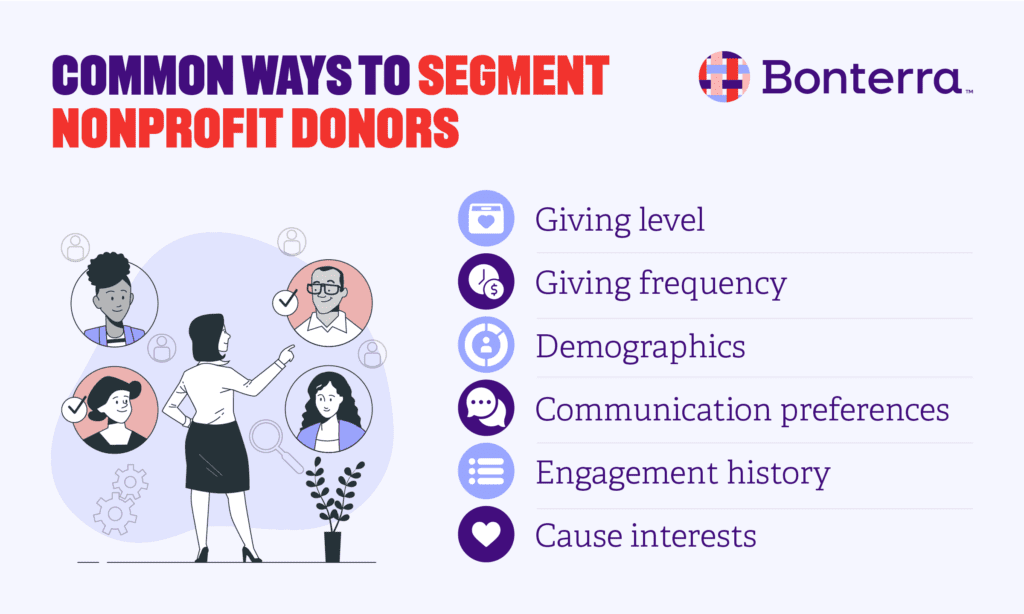
Giving level
If your organization is new to donor segmentation, start dividing your donors up by giving level. Segments for micro, minor, mid-level, and major donors are essential for recognizing every supporter appropriately. Those who give at higher levels expect (and deserve!) more thorough appreciation efforts, such as a handwritten thank-you letter instead of an email.
Before segmenting donors, some nonprofits create a visualization called a donor pyramid to define giving levels and their criteria. If you’re unsure what qualifies as a minor or major donation for your nonprofit, this is a good first step.
You can then break these segments down further for more tailored communications. This might look like a segment of first-time minor donors who gave less than $100 or a group of mid-level donors who mainly give at fundraising events. General giving level segments are valuable but don’t allow for enough personalization without breaking them down into smaller groups.
Giving frequency
Grouping donors based on how often or regularly they give helps you tailor fundraising appeals and send them at the most impactful times. Using this donor segmentation strategy, you might create segments for:
- Monthly or recurring donors: Those who give regularly, usually with automatic payments through your recurring giving program
- Annual donors: Supporters who give their largest contribution to your nonprofit at the same time each year
- Repeat donors: Those who don’t follow a standard giving frequency but tend to donate more than once a year
- Lapsed donors: Supporters who donated in the past but have since stopped giving
For your recurring donor segment, you should send thank-you messages multiple times a year and set up a trigger in your database to remind them when their payment method expires.
Annual donors, on the other hand, might receive regular updates about your organization’s work but limited fundraising appeals until the time of year when they typically make their donation. Then, you might analyze the giving potential of each donor in that segment to create personalized donation requests that encourage them to increase the size of their annual gift.
Demographics
Many types of demographic data can indicate common preferences and beliefs. For instance, donors belonging to Gen Z are more likely to prefer engaging with your nonprofit on social media and supporting social justice causes. By segmenting donors based on their demographics, you can more easily cater to these preferences.
You likely have plenty of demographic information about your donors already. Demographic data includes:
- Age.
- Gender.
- Location.
- Career field.
- Marital status.
- Income.
- Level of education.
As mentioned earlier, your segments will be more effective if you hone them further. Use other types of donor data to refine your demographic segments. This might look like a group of mid-level Gen Z donors who work in STEM fields or a segment of local retired donors who volunteer at least once a month.
Communication preferences
You can gather information about supporters’ communication preferences through direct methods like surveys or by analyzing their engagement with your messages. Then, use donor segmentation to help you adhere to these preferences, boosting the chances that donors will read and interact with your communications.
If a donor only responds to text messages, for instance, place them in a segment of supporters who favor SMS. You might still send occasional emails to these donors but focus your outreach strategies on text messages.
Engagement history
Your donors engage with your organization in several ways beyond giving. Noting of how different groups engage helps you tailor your invitations to get more involved, ensuring that you offer the right activities to the supporters most likely to accept them.
A donor’s engagement history takes into account involvement like:
- In-person and online volunteering.
- Attending events.
- Fundraising on your organization’s behalf in a peer-to-peer fundraiser.
- Advocating for your organization.
- Serving on your board or a committee.
For easier donor segmentation, consider quantifying supporters’ engagement levels to quickly gauge which donors are highly engaged. Streamline this process with donor engagement software by assigning supporters points based on their involvement history.
Cause interests
Each donor has their own reasons for giving to your organization. The more you can appeal to these motivations in your fundraising appeals, the more likely you are to earn their donations. Whenever you learn that a donor aligns with a specific aspect of your cause, add them to a donor segment so you can tailor future appeals and outreach efforts.
For example, a human rights nonprofit might create segments for donors most interested in amnesty, racial justice, and LGBTQ rights.
5 tips for leveraging donor segmentation effectively
There are countless ways to create highly specific, effective segments using the common donor segmentation factors we discussed. Use these baseline strategies to compile and leverage the best donor segments for your organization.
1. Develop meaningful, specific donor segments.
As you begin segmenting donors, determine which groups are most relevant to your organization’s goals. The segments you create for your nonprofit should align with your immediate and long-term objectives, the unique characteristics of your donor base, and the information you have on hand.
For instance, newer nonprofits might not have a significant major donor segment yet, while organizations that support social justice causes need to heavily factor advocacy campaign involvement into their segmentation strategy. Meanwhile, another nonprofit that’s focusing on soliciting corporate gifts should prioritize employment information and matching gift eligibility.
Outline your current goals, then consider what types of donor data would help you reach those goals. Create initial donor segments and refine them several times by adding more helpful specifics. If your goal is auction promotion, you might start segmenting by giving level, then divide each of those segments based on past event attendance and preferred communication method. This way, you’ll end up with specific segments like “mid-level donors who frequently attend events online and prefer emails.”
2. Adapt your donor segmentation strategy often.
Your goals will shift as your nonprofit grows, and your donor segmentation strategy should evolve accordingly. Re-evaluate your donor segments on a regular cadence by asking questions like:
- How have our organization’s goals changed since we last segmented our donors?
- Which of our current donor segments are most relevant to those goals?
- Are any major segments missing from our database?
- How could we better support our goals with donor segmentation?
- Do we need to address any gaps in supporter data?
- Have we applied our donor data productively?
Beyond analyzing your donor segmentation strategy periodically, you should also adapt or create new segments when you introduce new programs.
For instance, if you create a new donor membership program, you could compile the donors who join at each level into new segments and refine any relevant existing segments to account for membership levels. In the example below, an organization uses Bonterra Fundraising and Engagement to create a new segment that includes National Members, Platinum Members, and sustainers.
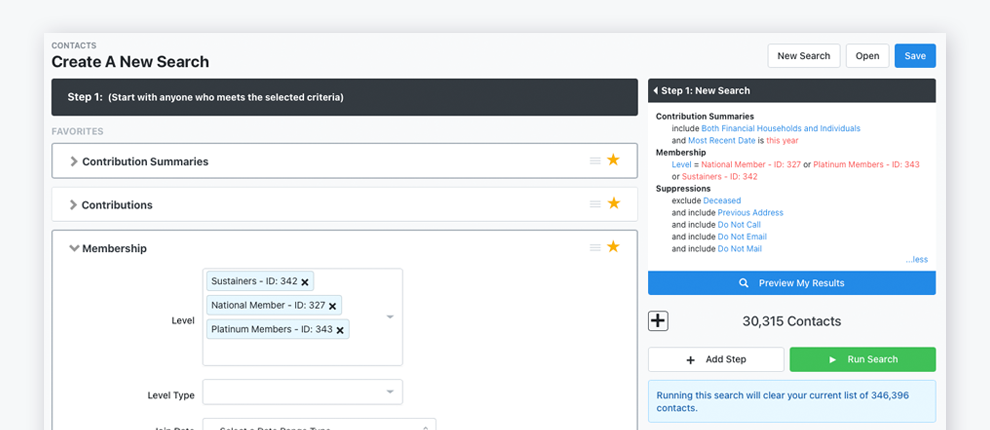
3. Remember to include volunteers.
When nonprofits segment supporters, they often focus on donors to boost fundraising results. However, your segmentation strategy can also help you understand and engage with volunteers, who help further your purpose in different yet essential ways.
Using software to segment volunteers can help you:
- Track volunteer-to-donor conversions. Your volunteer base is one of the best places to find new donors. Learn what engagement opportunities inspire volunteers to give and what fundraising methods appeal to them. Then, monitor which of your volunteers follow through with donating.
- Offer tailored opportunities to different volunteer segments. Volunteers who enjoy their work are more likely to stay involved with your cause, so it’s useful to provide opportunities based on volunteers’ interests. For example, an animal shelter might group supporters based on whether they prefer dogs or cats and promote different volunteer opportunities to each segment.
- Leverage volunteer grants. Volunteers who participate in their employers’ workplace giving programs can amplify their impact on your cause. Create a supporter segment whose employers offer volunteer grants so you can bring in additional revenue when those individuals volunteer.
By addressing your volunteer segments with the same care as your donor segments, you can build stronger relationships with all of your supporters and demonstrate that each supporter is valuable no matter how they choose to get involved with your organization.
4. Create an action plan.
Donor segmentation doesn’t end with creating segments. After segmenting your donors, you must use these groups effectively to improve your outreach, fundraising strategies, and donor engagement efforts.
Design one or more action plans that break down how you plan to target different donor segments and over what timeframe. Each plan should support a specific goal and guide your team’s efforts to reach every supporter in the most personalized, relevant ways. For instance, you might create a stewardship matrix that outlines how you’ll thank and steward donors at each giving level:
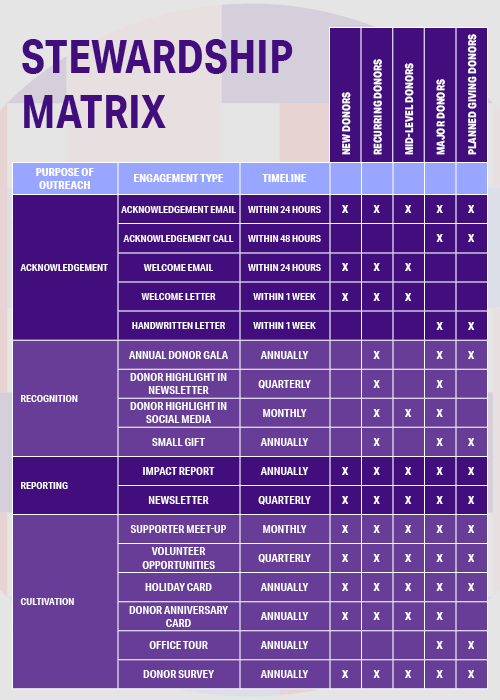
In this donor segmentation example, the nonprofit defines when its team will send specific stewardship messages to new donors, recurring donors, mid-level donors, major donors, and planned giving donors.
5. Build your fundraising strategy around donor segmentation.
Your completed plan of action should inform your nonprofit’s fundraising strategy. As you choose fundraising initiatives each year, review the previous year’s data and consider the preferences of your most important donor segments.
For instance, you might plan event fundraisers based on which segments would find them most appealing. If your major donors enjoy attending formal events, inviting them to an annual gala could help retain their support over time. However, if you notice that a growing number of supporters have young children, you might also host a fun run or family-friendly movie night fundraiser to engage that segment.
Or, say that your organization needs to engage all donor segments on GivingTuesday to bring in critical year-end funding. Many nonprofits create GivingTuesday social media campaigns, which younger audiences often prefer, but your older donors may be more receptive to a direct mail solicitation. Appeal to both segments by creating multiple types of content and adjusting your messaging for each channel based on their unique interests.
Improve your fundraising results with donor segmentation.
The more you know about your donors and leverage that knowledge via segmentation, the better you’ll understand your community and connect with each supporter. Just remember to continue evaluating your strategy and keep your donor segmentation information up to date to improve fundraising outcomes over time.
Segment donors and tailor appeals easily with Bonterra Fundraising and Engagement.
Work with Bonterra



